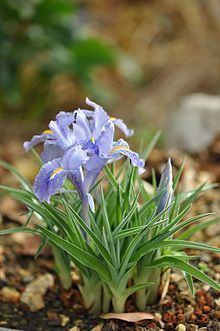Tribe Irideae Rank Species | Subfamily Iridoideae | |
 | ||
Similar Iris marsica, Iris sintenisii, Iris filifolia, Iris orientalis, Iris bicapitata | ||
Lirio silvestre iris planifolia www riomoros com
Iris planifolia is a species in the genus Iris, it is also in the subgenus of Scorpiris. It is a bulbous perennial.
Contents
- Lirio silvestre iris planifolia www riomoros com
- Lirio de invierno iris planifolia http www riomoros com
- Habit
- Native
- References
The name is derived from 'planifolia' from the Greek word meaning 'with flat leaves'.
It was first published by T.Durand and Schinz in 'Conspectus Floræ Africæ' No5. in 1894. But under the name Iris alata.
Fiori and Paoletti in 'Flora Analytica d'Italia', recognized this species as the genus Iris from Millers original entry of 'Xiphium planifolium'. For many years this was known under the synonym. 'Iris alata' by Poir and recorded in a 1939 checklist. Further research took then plant origin back to 1894.
Iris planifolia is now the accepted name by the RHS. Note; Iris planifolia has over 20 different synonyms. See list in the infox on the right. 'Iris alata' (also commonly known as 'Scorpion Iris') is the most common synonym.
It is hardy to USDA Zone 3.
The bulb is a short lived plant. It is better grown in the UK, in a bulb frame. In pots or preferably in the ground.
It can also be cultivated in pots. But the pots need to be a minimum of 30 cm tall (or 1 ft), to allow maximum root space.
It needs good ventilation to prevent disease, but can be prone to virus infections. Causing a loss of growth, and causes pale or streaky foliage. Infected plants should be destroyed to stop contamination of other plants.
For good growth next year, it prefers a good warm dry ripening period in summer, in sharply drained soil.
Lirio de invierno iris planifolia http www riomoros com
Habit
Iris planifolia has a large brown ovoid bulb (around 2in in diameter), with fleshy cylindrical white roots.
It is regarded as having one of the largest flowers in the sub-genus.
It can begin to flower in December, up to January or February. In the wild they have been known to flower in later Autumn. The flowers have a light scent, which can be described as spicy. It is a short, stout plant which blooms with up to three large flowers per stem, which are generally 6–7 cm in diameter, with a perianth tube of 8–18 cm long. It has falls that are 5–8 cm long and standards that are 2 cm long. The plant can reach a maximum height of 10–15 cm tall.
The large flowers can come in various shades of blue, from bluish violet, bright sky blue and lilac blue, The falls have a dark blue veining and a yellow crest on the ridge. It does not have a beard.
Occasionally, white flowered forms can be found in the wild.
It has shiny green leaves that grow up to 10–30 cm long and 1–3 cm wide. Which can conceal the short stem, at flowering time. The leaves are lanceolate, and begin narrow at soil level before growing up towards a point.
Capsule oblong, sessile like that of Colchicum on the surface of the soil in the centre of the leaves. It has brown seeds which can be as large as a pea.
It can be propagated naturally as it creates clumps of bulbs, that can be divided, by being very carefully teased apart in late summer. Care mus be taken not to damage the fleshy roots.
Native
This the only species in the Juno subgenus that can be found growing in Europe.
Iris planifolia is found on rocky hillsides, which are generally wet in the winter and dry in the summer. It can be found in a wide area of southern Europe to Northern Africa.
Specifically in Crete, Greece, Sicily, Spain, Portugal, Sardinia, and Morocco.
White forms of the iris can be found in Andalucia.
